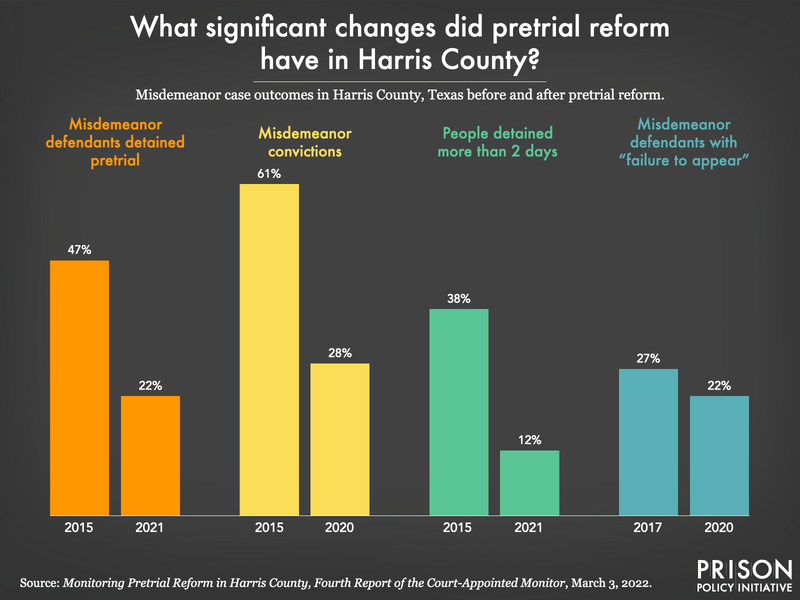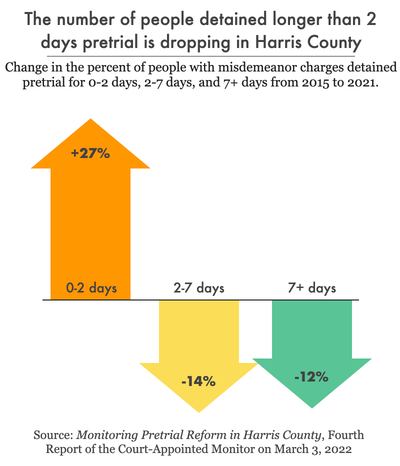What does successful bail reform look like? To start, look to Harris County, Texas.
New data supports what advocates have been saying all along: there’s no need to detain so many people pretrial.
by Emily Widra, March 28, 2022
New data is out that supports bail reform efforts to end reliance on cash bail, minimize the number of people charged with misdemeanors and detained pretrial, and improve misdemeanor bail hearings. The recently published findings come from researchers charged with monitoring misdemeanor pretrial reform as it is implemented in Harris County (Houston), Texas.
In the most recent report on Harris County’s pretrial reform, the monitoring team reviewed the results of the changes implemented so far, and generally found that the reforms are successfully addressing some of the most pressing issues with misdemeanor pretrial detention. We highlight some of the most significant results they report about Harris County’s misdemeanor bail reform so far:

Fewer people charged with misdemeanors and detained pretrial
Most people in city and county jails across the country are detained pretrial, meaning they are legally innocent and have not been convicted of the crime they are held for: too often, they are jailed because they cannot afford the cash bail set by the court. In Harris County, the percent of misdemeanor defendants detained pretrial dropped from 47% in 2015 to 22% in 2021. Unfortunately, a number of people are still detained despite the Consent Decree and subsequent reforms, for felony cases or because of “holds” for other agencies such as probation, parole, or immigration. (See report, Figure 12, p. 37)
Fewer misdemeanor convictions
Pretrial detention increases the odds of misdemeanor conviction, largely because detention pressures people to take plea deals when otherwise their case would likely be dismissed or they would be acquitted. By reducing the pretrial detention rate, the percentage of misdemeanor cases resulting in conviction dropped 54% from 2015 to 2020 in Harris County. Conversely, the percentage of misdemeanor cases resulting in dismissal or acquittal increased from 31% to 68% between 2015 and 2020. (See report, Figure 16, p. 43)

Shorter periods of being locked in jails
Because pretrial detention can have disastrous consequences for employment, housing security, and families, reducing the amount of time defendants spend behind bars is crucial. From 2015 to 2021, the percent of misdemeanor defendants detained pretrial in Harris County for 2-7 days dropped 14% and those detained for more than 7 days dropped 12%. Shorter stays became more common, with the share of defendants released within 2 days increasing by 27%. (See report, Table 3, p. 35)
Fewer “failures to appear” and no increase in pretrial arrests for new offenses
Two of the most commonly cited goals of pretrial detention and cash bail are to guarantee court appearances and reduce the likelihood of re-arrest before trial. But in Harris County, reducing the number of people detained pretrial actually decreased the rate at which people either missed their court date or had their bond revoked for some other reason (such as re-arrest) by 5%. Additionally, the share of misdemeanor arrestees with a new case filed within 90 days, 180 days, and 365 days remained unchanged following the reforms, suggesting that pretrial detention does not increase court appearances or reduce the chances of pretrial re-arrest. (See report, Table 6, p. 46 & Figure 14, p. 40)
Millions of dollars saved by the county and defendants
Conservative financial estimates suggest that Harris County saved $6.6 million per year from these changes and that individuals arrested for misdemeanors saved $314 million as a group over the past seven years. (See report, p. 51)
No increase in racial disparities
Unlike some other pretrial reform efforts, there is no evidence that racial disparities widened following the Harris County bail reforms. From 2015 to 2021, 58-59% of misdemeanor defendants in Harris County were Black. The reforms have not yet reduced disparities, either: The share of Black people arrested for misdemeanors in Harris County is still substantially higher than for misdemeanor arrests nationally (26%) and significantly higher than the share of Black residents of Harris County (20%). (See report, Figure 4, p. 26)
These new findings clearly support the bail reform efforts taken so far in Harris County, and should serve to embolden policymakers to take similar action in their own jurisdictions. Unfortunately, Texas officials themselves seem to be ignoring the evidence that bail reform can safely reduce unnecessary jailing. Just before these findings were published, Texas Governor Abbott signed Senate Bill 6 into law, eliminating the possibility for release on personal bond for “violent” crimes (or for those who are charged with any felony, misdemeanor assault, deadly conduct, or gun charges while out on bail for a “violent” offense).1
While the Harris County reforms focused on misdemeanors and this new law is concerned with felonies, previous research offers a plethora of evidence supporting bail reform at both the misdemeanor and felony levels. In fact, 2017 research from Harris County suggests that pretrial detention can actually increase the odds of future offending and reviews of pretrial reform across the country reveal that increased pretrial release does not result in increased crime. On an individual level, pretrial detention often has detrimental effects on an individual’s employment, housing, financial stability, and family wellbeing. The evidence from Harris County and from other states that have implemented more robust pretrial reforms — like Kentucky and New Jersey — demonstrates that these reforms are common-sense changes that save money, protect individuals and families, and uphold justice and community safety alike.
Footnotes
-
Senate Bill 6 — or “the Damon Allen Act” — is named after a state trooper who was killed during a 2017 traffic stop. The suspect in his death was out on a $15,500 bond (meaning he paid the amount of cash bail set by the court), and therefore the reactionary efforts of this bill would not have changed the conditions of his release back in 2017. (And, it’s important to note, his release was prior to the 2017 lawsuit that resulted in the Harris County misdemeanor bail reforms discussed above.) ↩
Updated March 29, 2022 with a graphic that more clearly shows the changes in outcomes for misdemeanor defendants, and with text changes that reflect the relative (percent) change in rates rather than the net change in rates for these outcomes.



